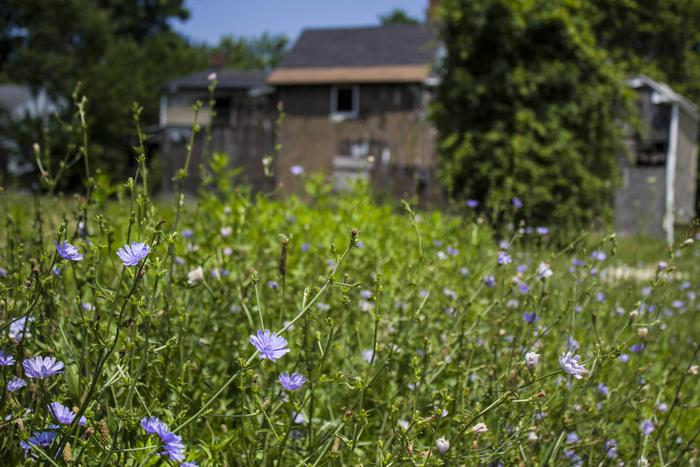
In the rapidly urbanizing landscapes of today’s world, the survival of pollinators is becoming an increasingly urgent ecological concern. A groundbreaking study recently published in Ecology and Evolution sheds new light on a less obvious threat facing these essential insects: the contamination of urban soils with toxic trace metals and their accumulation in wildflowers, which serve as vital forage for pollinators. Conducted in the post-industrial city of Cleveland, Ohio, the research unveils the complex interplay between urban soil contamination and pollinator health, offering crucial insights for conservation efforts in cities globally.
Pollinators such as bees, butterflies, and other nectar-feeding animals depend heavily on flowering plants that thrive in wild or semi-wild urban lots. These often-overlooked patches of greenery provide indispensable nutrients through nectar and pollen. However, many of these lands, frequently abandoned or vacant lots, have a legacy of industrial use, leaving them contaminated with hazardous metals like lead, arsenic, cadmium, and chromium. These metals have been well-documented as detrimental to insect health, interfering with physiological and neurological functions, ultimately impacting foraging behaviors and survival rates.
The study’s methodology involved the extraction and chemical analysis of nectar from self-seeded flowering plants commonly found across Cleveland’s disused urban spaces. Researchers systematically measured the concentration of several toxic metals in the nectar, discovering that lead was persistently present in the highest amounts. This finding directly corroborates the elevated levels of lead previously identified in the city’s soils, highlighting the unremitting legacy contamination inherent to post-industrial cities.
Crucially, the investigation exposed notable interspecies variations in metal accumulation. Chicory (Cichorium intybus), a bright blue-flowered species prevalent in urban environments, was found to amass the greatest total metal concentration. Other commonly found wildflower species, such as white clover (Trifolium repens), wild carrot (Daucus carota), and bindweed (Convolvulus arvensis), also exhibited metal uptake, but to varying extents. This differentiation underscores the importance of species-specific responses when considering urban planting and pollinator conservation strategies.
Trace metals in nectar present a direct exposure route to pollinators. Even minute metal concentrations have been implicated in subtle but significant behavioral impairments in bees, including compromised learning and memory. Such neurological damage diminishes foraging efficiency, which is critical for colony sustenance and growth. Over time, these effects accumulate, contributing to population declines that exacerbate the already worrying global reduction in wild pollinator numbers.
Urban soil metal contamination is not an isolated phenomenon confined to Cleveland; it is a global concern, attributed to cumulative industrial emissions, transportation pollutants, historical mining activities, and urban development materials such as cement dust. Older cities with extensive industrial legacies often exhibit higher soil contamination levels, creating an insidious barrier to healthy urban ecosystems. Understanding this geographical and historical context is fundamental when planning urban greening initiatives aimed at pollinator support.
The research advocates for rigorous site assessment and soil testing prior to the establishment of urban wildflower habitats, emphasizing the need for a precautionary approach. Pollutant remediation or soil replacement should be considered essential steps where contamination exceeds safe thresholds. Simply planting pollinator-friendly wildflowers without addressing underlying soil toxicity may inadvertently contribute to the bioaccumulation of harmful metals in the food web.
Moreover, the study highlights the dynamic role of plant management in mitigating metal transfer risks. For example, frequent mowing of wildflower patches can limit flowering, thereby reducing nectar availability for pollinators but concurrently decreasing the amount of contaminated nectar ingested. Such management tactics represent a complex but necessary balance between providing forage resources and minimizing exposure to toxins.
The broader environmental implications resonate deeply, given pollinators’ indispensable role in sustaining agricultural productivity and biodiversity. Many key crops, including apples and tomatoes, depend heavily on pollinator visits for fruit set and yield. Natural pollination services are estimated to contribute billions of dollars to the global economy annually, a testament to the profound ecosystem services pollinators provide. Their decline, fueled by habitat loss, climate change, pesticide exposure, and now confirmed soil contamination, signals a multifaceted crisis with far-reaching consequences.
Dr. Sarah Scott of the University of Cambridge, the lead author of the study, emphasizes the nuanced message emerging from these findings. While urban wildflower planting remains a valuable conservation tool, the underlying soil health must not be overlooked. She stresses the importance of conducting soil tests to ascertain contamination levels and accessing cleanup resources if necessary. This integrative approach ensures that conservation measures support, rather than inadvertently undermine, pollinator wellbeing.
In light of the study’s revelations, urban planners, ecologists, and policymakers are urged to incorporate environmental history and soil quality assessments into the planning and management of urban green spaces. Tailoring species selection to the specific conditions of soil contamination and adopting adaptive management strategies can collectively enhance the efficacy of pollinator conservation efforts within cities.
Ultimately, this research not only advances scientific understanding of urban ecology and pollinator interactions but also beckons a paradigm shift in how urban biodiversity conservation is conceptualized. The legacy of industrial activity extends beyond the visible scars on the landscape — it invisibly permeates the nectar that fuels pollinator survival. Addressing these hidden threats requires an interdisciplinary approach, marrying soil science, toxicology, plant ecology, and urban management to forge resilient habitats for these vital creatures.
As global urbanization accelerates, the imperative to safeguard urban pollinator populations grows ever more pressing. This study illuminates a critical pathway toward that goal, offering actionable insights grounded in meticulous empirical research. By acknowledging and managing the complex chemical legacies embedded in urban soils, society can foster vibrant, healthy pollinator communities that not only enrich urban biodiversity but also underpin food security and environmental resilience worldwide.
Subject of Research: Trace metal contamination in nectar of urban pollinator forage plants and its direct exposure risks to pollinators and nectar-feeding animals.
Article Title: Trace metals in nectar of important urban pollinator forage plants: A direct exposure risk to pollinators and nectar-feeding animals in cities
News Publication Date: 15-Apr-2025
Web References: DOI link
Image Credits: Credit: Sarah Scott
Keywords: urban pollinators, nectar contamination, trace metals, heavy metals, soil pollution, wildflowers, urban ecology, pollinator conservation, Chicorium intybus, lead contamination, nectar toxicity, urban soil remediation
Tags: abandoned urban lots and biodiversityCleveland Ohio environmental studyecological implications of urban soil toxicityeffects of industrial pollution on pollinatorsimpact of toxic metals on beesimportance of wildflowers for pollinatorsnectar analysis in contaminated soilspollinator health and urban soil contaminationrisks to insect health from urbanizationtrace metal accumulation in plantsurban ecology and conservationwildflower forage quality





